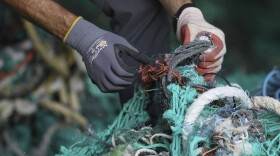Winston Churchill once said, “History is written by the victors.” But Native American filmmaker Chris Eyre thinks we can do better. Eyre is best known for directing the award-winning film “Smoke Signals.” He is the current Inouye Distinguished Chair in Democratic Ideals at UH M?noa. HPR's Ku?uwehi Hiraishi sat down with Eyre to discuss his new documentary exploring the role of statues in history.
Can history really be set in stone? That’s the question at the center of Chris Eyre’s upcoming documentary “Statues Between U.S.: Rethinking Symbols."

“There, you know, those statues are very much in the zeitgeist of politics,” says Eyre, “And we see it in the southeast quite a bit, which is, you know, do we take these Confederate statues down or do we leave them up?”
In cities across the United States, calls to take down monuments to Confederate leaders are sparking a lot of conversation. But for the southern Cheyenne and Arapaho filmmaker, this conversation was had in New Mexico decades ago. In 1997, the right foot of a statue honoring the state’s founder, a Spanish conquistador, was amputated and stolen.
“It was done 20 years ago. And he did it as an act of social commentary, political activism. Not as a defacing of a statue but as a symbolic gesture towards what this person who um was Don Juan Onate, the Spanish conquistador, did to native people."
Onate cut the right foot off of native people at Acoma Pueblo, and on the 400th anniversary of Onate’s conquest of New Mexico, the unnamed foot thief sawed off the foot on Onate’s statue, and for 20 years it was a mystery, until the man shared his story and the foot with Eyre.

“So we in this documentary discuss with him, Why he did what he did? Why he’s interested in talking? Would he do such an act again? And what he thinks is going on with confederate statues?” says Eyre.
Eyre gave a sneak peek of his latest cinematic pursuit to an audience at UH M?noa. Jacob Wruck, a Hawaiian studies major at Leeward Community College, was there and remembers hearing about the New Mexico foot thief.
“I actually always wondered what had happened with it, so it was nice to see what had happened,” says Wruck, “And when all the things about confederate soldiers started up, I was thinking the exact same thing. It was completely fitting to today.”

Noelle Kahanu, a specialist with the American Studies Department at UH M?noa, helped organize the event.
“It’s really timely in terms of the conversations that people are having right now about all the different statues throughout the U.S.” says Kahanu, “But it’s still relevant to Hawai’i too, even as we think about issues like you know McKinley High School, even here on campus the renaming of Porteus.”
“It’s just something about being a human being. And seeing the treatment that other human beings have receive,” says Wruck, “And also the kind of sugar coating or white washing of different things over the decades kind of you know history being written by the victors um but that not being the full story.”

“We talk about the history of this country from a native perspective because that is the invisible group,” says Eyre of his documentary.
“It’s not all hunky dory. It’s not, you know, just cause we put a statue up of a conquistador or a confederate general doesn’t mean everybody is ok with it,” says Wruck.
“This is a subject, you know, statues and what statues symbolize to us and what they symbolize to other people, it’s a subject that’s not going to go away,” says Eyre.
Eyre’s documentary is set to be completed next summer.




